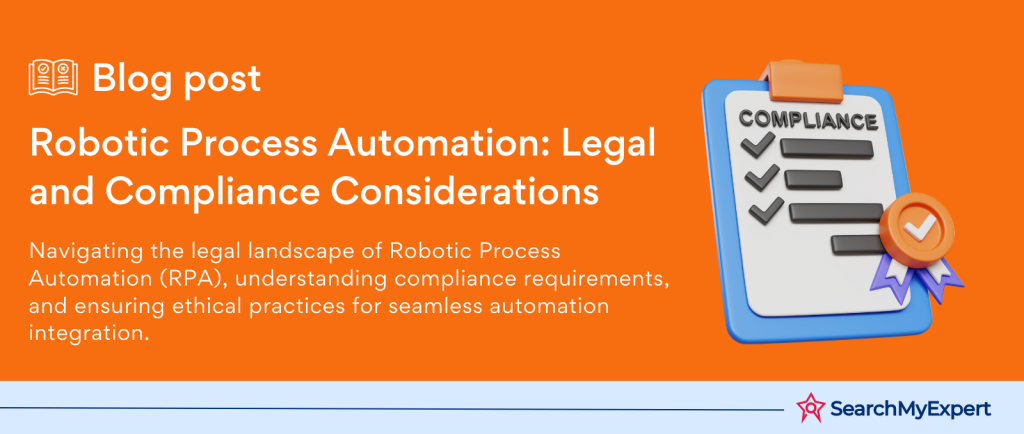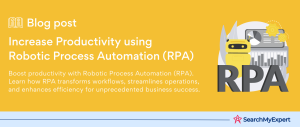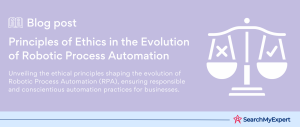Legal and Compliance Issues in Robotic Process Automation
Define RPA: Robotic Process Automation Explained
Robotic Process Automation (RPA): it’s the tech game-changer you’ve heard about! Imagine a world where software robots handle repetitive, boring tasks. That’s RPA for you. This technology uses “bots” to automate routine, rule-based digital tasks. It’s like having a virtual workforce, working 24/7, without coffee breaks!
Capabilities and Benefits:
- Efficiency Unleashed:
Bots complete tasks quicker and without errors. - Cost Savings:
Automation cuts operational costs. More work, less manpower. - Scalability and Flexibility:
RPA scales up or down based on your needs. - Enhanced Accuracy: Bots follow rules to the letter, reducing human error.
- Employee Liberation:
Humans are freed from mundane tasks, focusing on more strategic work.
Rising Adoption: RPA’s Industry-wide Embrace
RPA isn’t just a fad; it’s a revolution. Industries far and wide are jumping on the bandwagon. From banking to healthcare, retail to manufacturing, RPA is spreading its wings. It streamlines processes, enhances customer experiences, and drives innovation. The stats are speaking: RPA adoption is sky-rocketing!
Compliance Gap: Navigating the Legal Maze
With great power comes great responsibility, and RPA is no exception. As RPA transforms business operations, it also brings forth a plethora of legal and compliance challenges. Issues like data privacy, security, and regulatory compliance are at the forefront. Businesses need to tread carefully, ensuring their RPA journey aligns with legal frameworks and industry standards.
Data Privacy and Security Risks
Data Types: Sensitive Data in the Hands of RPA
When RPA bots step into the workplace, they don’t just shuffle papers – they handle data and not just any data. We’re talking sensitive information:
- Personal Data:
Names, addresses, and those personal details that make you, well, you. - Financial Info:
Credit card numbers, bank details – the stuff you don’t want leaked. - Confidential Corporate Data:
Trade secrets, business strategies – the corporate crown jewels.
Breach Threat: The Dark Side of RPA
Bots are great, but they’re not invincible. Here’s the risk: data breaches. Imagine sensitive information falling into the wrong hands because of a bot slip-up. The consequences? Catastrophic. Financial loss, reputational damage, and legal nightmares.
Regulatory Landscape: Navigating the Data Privacy Maze
Enter GDPR, CCPA, and the alphabet soup of data privacy regulations. These laws are like the rulebooks for handling personal information. They say, “Do this, don’t do that,” especially when it comes to consumer rights and data protection. RPA must play by these rules, or face hefty fines and loss of trust.
Mitigation Strategies: Playing It Safe with RPA
Prevention is better than cure, especially in data security. Here’s how to keep RPA safe and sound:
- Access Control: Keep a tight leash on who can interact with your bots.
- Audit Trails:
Keep track of what your bots are doing. Transparency is key. - Data Encryption: Make your data as unreadable as ancient hieroglyphics to unauthorized eyes.
- Regular Updates and Patches: Keep your RPA system in tip-top shape, security-wise.
Intellectual Property (IP) Ownership and Licensing
Who Owns the Bot? Unraveling Legal Ownership
Ownership of RPA bots is a complex legal tangle. Here’s the breakdown:
- Developers:
They build the bot. But does creation equal ownership? - Users:
Companies using the bot. They own the processes, but what about the bot itself? - Software Providers: They provide the RPA platform. Often, they retain ownership rights.
Software Licensing: Navigating Legal Waters
RPA software licensing is no walk in the park. Here’s the scoop:
- License Agreements:
These are key. They dictate terms of use and limitations. - Usage Restrictions:
Often, licenses restrict how and where the RPA can be used. - Vendor Lock-in:
Dependency on specific RPA vendors can be a legal knot.
IP Infringement Risks: A Legal Minefield
RPA can accidentally step into IP infringement. Here’s what to watch out for:
- Copyright Infringement:
Using copyrighted code or processes in your bot. - Patent Issues:
Accidentally infringing on patented RPA technologies.
Contractual Safeguards: Fortifying Your Legal Position
Here’s how to safeguard your RPA projects:
- Clear Contracts: Define who owns what. Make it crystal clear.
- Licensing Strategies:
Choose licenses that align with your business needs. - IP Clauses:
Include specific IP terms in your contracts with developers and vendors.
By implementing these strategies, organizations can navigate the complexities of IP ownership and licensing in RPA, ensuring a legally sound and effective deployment of this transformative technology.
Liability and Accountability for Robot Actions
Attribution of Blame: Pinpointing Responsibility
When RPA bots falter, who’s to blame? It’s a legal conundrum:
- Software Providers:
Are they liable for flaws in the bot’s design? - Users/Companies:
Do they bear responsibility for how the bot is deployed? - Developers:
What if the error lies in the bot’s programming?
Legal Framework: Navigating the Labyrinth
The legal framework for RPA liability is a patchwork:
- Negligence: Did someone fail to take reasonable care in deploying the bot?
- Product Liability:
Can errors be traced back to inherent flaws in the bot? - Contractual Liability:
What do the agreements say about responsibility?
Mitigating Risks: Strategies for a Safer RPA Journey
Minimizing RPA risks requires foresight and planning. Key strategies include:
- Insurance Coverage:
Policies specifically for technology errors and omissions. - Human Oversight: Keeping a human in the loop for critical decisions.
- Regular Audits and Updates:
Ensuring bots operate as intended and adapt to changes.
These measures can form a robust shield against potential liabilities, paving the way for safer and more responsible use of RPA technology.
Regulatory Compliance Challenges
Affected Industries: RPA’s Regulatory Ripple Effect
RPA’s adoption is reshaping regulatory landscapes. Key impacted sectors include:
- Finance:
Think AML (Anti-Money Laundering) and KYC (Know Your Customer). - Healthcare:
Patient privacy under HIPAA is a biggie. - Government:
Data handling and citizen privacy are at stake.
In each sector, RPA must dance to the tune of stringent regulations.
Adapting Compliance Frameworks: RPA’s New Rulebook
Existing compliance frameworks were not built with RPA in mind. The adaptation is crucial:
- Revisiting Policies:
Updating them to reflect the realities of RPA. - Risk Assessment:
Identifying how RPA impacts compliance risks. - Training and Awareness:
Ensuring staff understand RPA’s regulatory implications.
This adaptation is key to keeping RPA aligned with legal requirements.
Dynamic Regulations: Staying Ahead of the Curve
Regulations are not static, and neither is RPA. The challenge lies in:
- Keeping Updated:
Regulations evolve, and so must RPA strategies. - Flexibility: RPA systems must adapt quickly to regulatory changes.
- Proactive Monitoring: Staying one step ahead of potential compliance issues.
Navigating this dynamic landscape requires agility and foresight.
Best Practices for Compliance: Building a Robust Framework
Here’s how to bulletproof your RPA compliance:
- Comprehensive Compliance Audits:
Regular checks to ensure adherence. - Documentation and Reporting:
Keeping meticulous records of RPA operations. - Collaboration with Regulators: Engaging with regulatory bodies for guidance.
- Ethical Considerations:
Factoring in ethical implications in RPA deployment.
By incorporating these practices, organizations can effectively navigate the complex world of regulatory compliance, ensuring their RPA deployments are both legally sound and ethically responsible.
Ethical Considerations and Algorithmic Bias
Transparency and Fairness: Unveiling the Ethical Veil in RPA
RPA isn’t just about efficiency; it’s also about ethics:
- Transparency:
Understanding how and why bots make decisions. - Accountability: Holding someone responsible for bot actions.
- Bias in Decision-Making: Ensuring bots don’t perpetuate unfair practices.
These concerns are fundamental for ethical RPA deployment.
Algorithmic Bias: The Invisible Hand in RPA
Bias in RPA can be insidious:
- Data Bias:
Bots trained on biased data will reflect those biases. - Programming Prejudices:
The creator’s unconscious biases can seep into the bot’s code.
The result? Unintended discrimination and skewed outcomes.
Mitigating Bias: Steering RPA Toward Fairness
Combatting bias in RPA requires proactive steps:
- Diverse Data Sets:
Training bots on a wide range of data to avoid skewed perspectives. - Regular Bias Audits:
Continuously checking for and correcting biases. - Ethical Programming Guidelines:
Developing bots with fairness in mind.
These practices are crucial for fostering responsible and ethical RPA use.
Human Oversight and Monitoring: The Human Touch in RPA
Machines are smart, but human wisdom is irreplaceable:
- Monitoring Bot Decisions:
Keeping a human eye on bot actions. - Intervention Protocols:
Having procedures to intervene when bots go astray. - Continuous Learning: Updating bots as our understanding of biases evolves.
Human oversight is the key to ensuring RPA operates not just efficiently, but also fairly and ethically.
Future Trends
Addressing Legal and Compliance Challenges: Navigating the RPA Maze
Implementing RPA presents an exciting opportunity for efficiency and productivity, but legal and compliance hurdles require careful consideration. Here are some practical recommendations to ensure a smooth journey:
- Conduct a thorough risk assessment:
Before plunging into automation, take a step back and analyze potential legal and compliance risks specific to your RPA goals. Identify the types of data your bots will handle, the relevant regulations they must adhere to, and any foreseeable liability concerns. - Build a robust compliance framework:
Don’t simply patch on compliance as an afterthought. Integrate it into the core of your RPA strategy. Develop clear policies and procedures for data access, security, and audit trails. Train your staff on these protocols and ensure regular monitoring of compliance adherence. - Seek legal counsel early on: Don’t shy away from professional expertise. Partner with a lawyer experienced in data privacy, intellectual property, and technology law. Their guidance can help you navigate the legal complexities of RPA and avoid potential pitfalls.
- Leverage industry best practices: Don’t reinvent the wheel. Learn from the experiences of others. Benchmark your practices against industry best practices for managing legal and compliance risks in RPA deployments. Many industry associations and technology vendors offer valuable resources and guidance.
- Foster a culture of awareness and accountability: Create a company culture where legal and compliance are not an alien concept but an integral part of everyday operations. Educate your employees about RPA-related risks and best practices. This shared responsibility will contribute to a more secure and compliant RPA environment.
- Stay informed and adaptable:
The regulatory landscape is constantly evolving. Stay updated on emerging trends and new regulations that might impact your RPA activities. Proactively adapt your compliance framework to ensure it remains aligned with the changing legal environment. - Embrace transparency and ethical development:
As RPA becomes more complex, so do ethical considerations. Ensure your bots are developed with transparency and fairness in mind. Avoid algorithms that could perpetuate bias or discrimination. Conduct regular audits to assess your programs for potential ethical concerns.
Emerging Trends: A Glimpse into the Future of RPA
RPA is a rapidly evolving field, and its future seems intertwined with several exciting trends:
- RPA and AI Convergence: We can expect a closer integration of RPA with Artificial Intelligence (AI). AI can empower bots with advanced decision-making capabilities, improving efficiency and adaptability. However, this convergence will raise new ethical and regulatory challenges regarding AI transparency and bias mitigation.
- Hyperautomation and the Internet of Things (IoT): RPA will likely play a key role in the broader trend of hyper-automation, where intelligent systems automate processes across diverse domains. This integration with IoT devices will further expand the reach and complexity of automated workflows, necessitating robust security and privacy measures.
- Democratization of RPA: As technology becomes more user-friendly, RPA tools could become accessible to smaller businesses and individual users. This democratization will require simplified platforms and robust security features to ensure responsible and secure automation practices.
- Regulatory landscape for intelligent automation: As RPA and AI converge, we can expect the emergence of new regulations and frameworks specifically tailored to address the risks and ethical considerations surrounding intelligent automation. Organizations will need to stay agile and adapt their compliance strategies to these evolving requirements.
Future of Work and Automation: Reshaping the Workforce
RPA will undoubtedly impact the future of work. While some jobs might be replaced by automation, new opportunities will arise in areas like bot development, maintenance, and oversight. It is crucial to prepare for this shift by fostering upskilling and reskilling initiatives to equip workers with the skills needed to navigate the changing landscape.
Conclusion
By proactively addressing legal and compliance challenges, staying informed about emerging trends, and preparing for the changing landscape of work, organizations can confidently leverage RPA to achieve greater efficiency, productivity, and competitive advantage. Remember, RPA is not simply a technological tool; it’s a transformative force that requires careful planning, ethical considerations, and continuous adaptation to ensure a future where humans and intelligent automation co-exist and thrive.
Elevate your process automation with our Robotic Process Automation Services.
Table of Contents
Toggle






